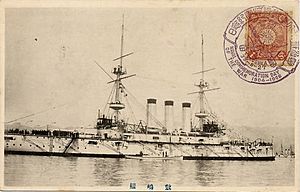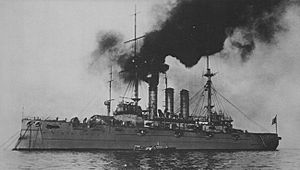Japanese battleship Shikishima facts for kids

Shikishima in a 1905 postcard
|
|
Quick facts for kids History |
|
|---|---|
| Name | Shikishima |
| Namesake | An old poetic name of Japan |
| Ordered | 1897 |
| Builder | Thames Iron Works, Blackwall, London |
| Laid down | 29 March 1897 |
| Launched | 1 November 1898 |
| Completed | 26 January 1900 |
| Reclassified | 1 April 1923 as transport and training ship |
| Stricken | 1923 |
| Fate | Scrapped, January 1948 |
| General characteristics | |
| Class and type | Shikishima-class pre-dreadnought battleship |
| Displacement | 14,850 long tons (15,090 t) (normal) |
| Length | 438 ft (133.5 m) |
| Beam | 76 ft 6 in (23.3 m) |
| Draught | 27 ft 3 in (8.3 m) |
| Installed power | |
| Propulsion | 2 shafts, 2 triple-expansion steam engines |
| Speed | 18 knots (33 km/h; 21 mph) |
| Range | 5,000 nmi (9,300 km; 5,800 mi) at 10 knots (19 km/h; 12 mph) |
| Complement | 741 |
| Armament |
|
| Armour |
|
The Shikishima (meaning "Scattered Islands," an old poetic name for Japan) was a powerful warship built for the Imperial Japanese Navy in the late 1890s. It was the first ship of its kind, known as a pre-dreadnought battleship, and was built in Britain.
This ship played a big role in the Russo-Japanese War from 1904 to 1905. It fought in major battles like Port Arthur, the Yellow Sea, and Tsushima. Even though it was slightly damaged in some fights, it kept going. After the war, Shikishima stayed in Japan during World War I. In 1921, it was changed into a coastal defence ship, then later used as a training ship for new sailors. The ship was taken apart in 1923 and finally scrapped in 1948.
Contents
What was the Shikishima Like?
The Shikishima and its sister ship, the Hatsuse, were designed in England. They were improved versions of the British Royal Navy's Majestic-class battleships. At that time, Japan didn't have the technology to build such large warships, so they had to be built overseas.
Shikishima was about 438 feet (133.5 m) long and 75 feet 6 inches (23.0 m) wide. When fully loaded, it weighed about 14,850 long tons (15,090 t) and had a crew of 741 officers and sailors. The ship was powered by two large steam engines that used steam from 25 boilers. These engines were designed to make the ship go as fast as 18 knots (33 km/h; 21 mph) (knots). However, during its tests, Shikishima actually reached a speed of 19 knots (35.2 km/h; 21.9 mph)! It could travel about 5,000 nautical miles (9,300 km; 5,800 mi) at a speed of 10 knots (19 km/h; 12 mph) before needing more coal.
Ship's Weapons and Protection
The main weapons on Shikishima were four large 12-inch (305 mm) guns. These were placed in two twin gun turrets, one at the front and one at the back of the ship. For closer fights, it had fourteen 6-inch (152 mm) quick-firing guns. These were placed along the sides of the ship and in its upper structure.
To defend against smaller, faster ships like torpedo boats, Shikishima carried many smaller guns. These included 20 3 inches (76 mm) guns and several 47-millimetre (1.9 in) guns. It also had four hidden torpedo tubes that could fire torpedos underwater.
For protection, Shikishima had strong Harvey armour around its middle, called a belt. This armor was 4–9 inches (102–229 mm) thick. The armor on its gun turrets was even thicker, up to 10 inches (254 mm). The ship's deck also had armor, ranging from 2.5 to 4 inches (64 to 102 mm) thick.
Shikishima's Journey and Battles
The name Shikishima is a poetic way to refer to Japan. This ship was one of four battleships ordered from overseas. Japan paid for these ships using money received from China after the Sino-Japanese War in the 1890s.
Shikishima was started on March 29, 1897, in London, England. It was launched into the water on November 1, 1898, and finished on January 26, 1900. After arriving in Japan, it was slightly damaged in September 1902 when a typhoon pushed it ashore near Yokohama.
Fighting in the Russo-Japanese War
When the Russo-Japanese War began in 1904, Shikishima was part of the 1st Fleet. Its first big action was the Battle of Port Arthur on February 9, 1904. The Japanese commander, Vice-Admiral Tōgō Heihachirō, planned a surprise attack on Russian ships. However, the Russians were ready, and the battle was tough. Shikishima was hit by one shell, which injured 17 crew members.
Shikishima also took part in an event on April 13, 1904. Admiral Tōgō managed to trick some Russian ships, including their flagship, the battleship Petropavlovsk, into leaving Port Arthur. The Petropavlovsk then hit a naval mine that the Japanese had placed. It sank very quickly after its ammunition storage exploded.
On May 14, 1904, a Japanese squadron, including Shikishima and its sister ship Hatsuse, sailed to help block Port Arthur. The next morning, they ran into a minefield laid by a Russian ship. Hatsuse hit a mine and lost its steering. While trying to help Hatsuse, another battleship, Yashima, also hit a mine. Hatsuse then drifted onto another mine, which caused its ammunition to explode, sinking the ship and killing many sailors. Yashima also sank later that day.
Shikishima was not hit during the Battle of the Yellow Sea in August 1904. However, one of its large 12-inch guns was damaged when a shell exploded too early inside it.
Battle of Tsushima
The most famous battle Shikishima fought was the Battle of Tsushima in May 1905. It was the second ship in the main line of Japanese battleships, right behind Admiral Tōgō's flagship, Mikasa. The Russian battleships focused a lot of their fire on Shikishima.
Shikishima was hit nine times during the battle. One serious hit went under a six-inch gun, harming the entire gun crew. Another 12-inch shell exploded too early in one of its front guns, completely wrecking it.
In return, Mikasa and Shikishima fired heavily at the Russian battleship Oslyabya. This ship eventually sank after two large shells made big holes in its front. This caused a lot of water to rush in, sinking it. This was the first time a modern battleship was sunk only by gunfire. During the battle, Shikishima fired many shells: 74 large 12-inch shells, 1,395 six-inch shells, and 1,272 smaller 12-pounder shells. It also fired a torpedo at a damaged Russian ship, the Ural, which caused it to sink.
Later Years
During World War I, Shikishima was based at Sasebo from 1914 to 1915. For the rest of the war, it was part of different naval squadrons.
After the Washington Naval Treaty was signed, which limited the number of warships countries could have, Shikishima was reclassified. On September 1, 1921, it became a first-class coastal defence ship. It was then used to train submarine crews. On April 1, 1923, it was reclassified again as a transport ship. Shikishima continued to be used as a training hulk (a ship that is no longer able to sail but is used for training) until it was finally taken apart for scrap metal in January 1948.



